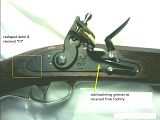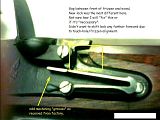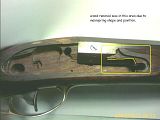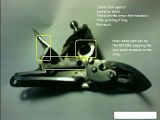I bought a used Italian (Euroarms/Zoli/Navy Arms) Harpers Ferry Model 1803 rifle.
Factory lock has internals that are of obscenely poor quality. Notches that don't work. Frizzen spring that was probably 20 lbs. No fly on tumbler. Etc. Etc.
Outside, the gun looks pretty nice. The frizzen did spark well. Maybe they just figured they would all be wall hangers.
R.E. Davis makes a Harper Ferry 1803 lock. They make it for kit guns. It is NOT a drop in replacement for the Italian repros.
My only beef is with some odd looking machining type grooves on the lockplate, under the frizzen spring.
Part# 1018 current price is $125
They were very helpful and offered to send me the lock and not charge my credit card (except for postage) until I had a chance to have gun and lock next to each other. If I didn't want it I could just send it back. All they could say about the replacement was that others had done it and there would be "gaps".
Link to R.E. Davis 1803 Harpers Ferry lock
Note: Parts for original lock parts from Euroarms can be steep. You have no expectation that they would be any better. They are not set up for credit cards, PayPal, etc.
I got a lock and here are pictures to document my NON-EXPERT gunsmith attempt to fit the lock.
The surgery took maybe 2hrs total.
Lockplate is shaped differently. (has pronounced "tit" at rear)
Some wood needs to be removed internally due to mainspring shape and placement.
Since new lock DOES NOT have pre-drilled and tapped holes for lock retaining screws, you will be able to make those fit existing holes exactly. (Note: metric threads).
Davis lock comes in the white with a sandblast (?) or beaded (?) finish. The Italian lock is case-hardened. I chose to brown my new lock.
Since I am a practical person was not OBSESSED with precise nit-picking historical accuracy AND wanted to still be able to (for some reason)
re-install the old lock AND thought it was easier for me to grind metal than carve wood AND the new lock was a little larger and allowed me to do so, I ground it to fit outline of old lock. This was done primarily at rear (the little "tit" shape) and the bottom edge.
If you have CONSTRUCTIVE ideas to improve or beautify the results...please let me (an others) know! Especially re the gap in front of frizzen.
Click on a picture for larger versions.





Factory lock has internals that are of obscenely poor quality. Notches that don't work. Frizzen spring that was probably 20 lbs. No fly on tumbler. Etc. Etc.
Outside, the gun looks pretty nice. The frizzen did spark well. Maybe they just figured they would all be wall hangers.
R.E. Davis makes a Harper Ferry 1803 lock. They make it for kit guns. It is NOT a drop in replacement for the Italian repros.
My only beef is with some odd looking machining type grooves on the lockplate, under the frizzen spring.
Part# 1018 current price is $125
They were very helpful and offered to send me the lock and not charge my credit card (except for postage) until I had a chance to have gun and lock next to each other. If I didn't want it I could just send it back. All they could say about the replacement was that others had done it and there would be "gaps".
Link to R.E. Davis 1803 Harpers Ferry lock
Note: Parts for original lock parts from Euroarms can be steep. You have no expectation that they would be any better. They are not set up for credit cards, PayPal, etc.
I got a lock and here are pictures to document my NON-EXPERT gunsmith attempt to fit the lock.
The surgery took maybe 2hrs total.
Lockplate is shaped differently. (has pronounced "tit" at rear)
Some wood needs to be removed internally due to mainspring shape and placement.
Since new lock DOES NOT have pre-drilled and tapped holes for lock retaining screws, you will be able to make those fit existing holes exactly. (Note: metric threads).
Davis lock comes in the white with a sandblast (?) or beaded (?) finish. The Italian lock is case-hardened. I chose to brown my new lock.
Since I am a practical person was not OBSESSED with precise nit-picking historical accuracy AND wanted to still be able to (for some reason)
re-install the old lock AND thought it was easier for me to grind metal than carve wood AND the new lock was a little larger and allowed me to do so, I ground it to fit outline of old lock. This was done primarily at rear (the little "tit" shape) and the bottom edge.
If you have CONSTRUCTIVE ideas to improve or beautify the results...please let me (an others) know! Especially re the gap in front of frizzen.
Click on a picture for larger versions.










